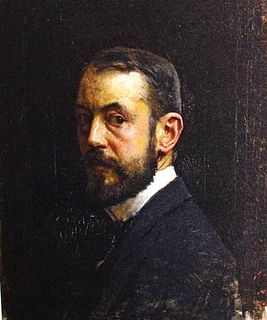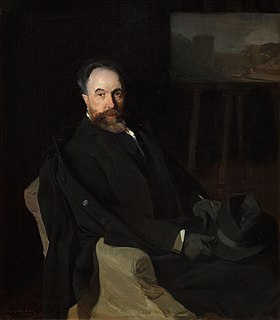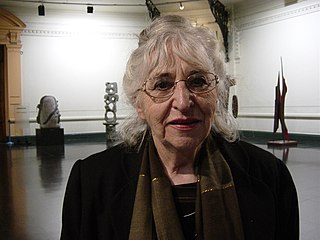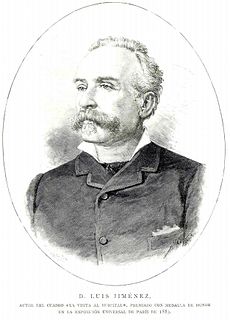
Marià Josep Maria Bernat Fortuny i Marsal, known more simply as Marià Fortuny or Mariano Fortuny, was the leading Spanish painter of his day, with an international reputation. His brief career encompassed works on a variety of subjects common in the art of the period, including the Romantic fascination with Orientalist themes, historicist genre painting, military painting of Spanish colonial expansion, as well as a prescient loosening of brush-stroke and color.

Raimundo de Madrazo y Garreta was a Spanish painter from the Madrazo family of artists who worked in the Realistic style, although his later work shows signs of Rococo and Japanese influence. He was known primarily for his genre paintings and portraits. His grandfather was José de Madrazo, his father was the portrait painter Federico de Madrazo and his brother was Ricardo de Madrazo.

Eduardo Rosales Gallinas was a Spanish painter. He was an adherent of the Italian-based art movement known as "Purismo" and specialized in historical scenes.

Vicente Palmaroli González was a Spanish portrait and genre painter.

José Moreno Carbonero was a Spanish painter and decorator. A prominent member of the Málaga School of Painting, he is considered one of the last great history painters of the 19th century. He was a celebrated portrait painter who enjoyed the patronage of Madrid's high society. He also created genre scenes and some landscapes, vedutas and still lifes.
The National Exhibition of Fine Arts was a regular event that took place in Spain from 1856 to 1968; usually in Madrid. These exhibitions were in the form of a competition, established by a Royal Decree from Queen Isabella II in 1853. It was the largest official exhibition of Spanish art.

Carlos Casado del Alisal was a Spanish Argentine businessman.

Carlos Sebastián Pedro Hubert de Haes was a Spanish painter from Belgium. He was noted for the Realism in his landscapes, and was considered to be the "first contemporary Spanish artist able to capture something of a particularly Spanish 'essence' in his work". He was cited along with Jenaro Perez Villaamil and Aureliano de Beruete as one of the three Spanish grand masters of landscape painting, the latter of which was his pupil.

Chilean art refers to all kinds of visual art developed in Chile, or by Chileans, from the arrival of the Spanish conquerors to the modern day. It also includes the native pre-Columbian pictorial expression on modern Chilean territory.

Benet Mercadé i Fàbrega, in Spanish: Benito Mercadé y Fábregas was a Catalan painter of portraits and historical scenes.

Dióscoro Teófilo Puebla Tolín was a Spanish painter in the Eclectic style who specialized in portraits, genre and history painting.

José María Casado del Alisal was a Spanish portrait and history painter.

Antonio Muñoz Degrain was a Spanish painter who began in the Eclectic style, later in his career he moved towards Impressionism. He is best known for his landscapes and scenes inspired by works of literature.

Aureliano de Beruete was a Spanish landscape painter, art critic and social activist.

Joaquín Agrasot y Juan was a Spanish painter of the Realistic style who produced many works in the Costumbrismo genre.

Francisco José Domingo y Marqués was a Spanish painter in the Eclectic style.

The Palacio del Marqués de Portugalete was a grand palace built in the 1860s, located at 56 Calle de Alcalá, on the corner of Calle Alfonso XI, in Madrid. Also known as the Palace of Bailén, it belonged to the family of Francisco Javier Castaños y Aragorri, a descendant of General Francisco Castaños, who was the victor at the Battle of Bailén. It was built by architect Adolfo Ombretch, who also built the nearby palace of Linares. For many years it was a venue for the wealthy elite to meet and discuss national politics. It was demolished after the Spanish Civil War, and in 1946, replaced by the National Institute of Forecast, now occupied by the National Institute of Health.

Gracia Barrios Rivadeneira was a Chilean painter and the winner of the 2011 National Prize for Plastic Arts.

Jose Aranda was a Spanish-born French painter of genre scenes; many in costumbrista style. His brothers, José and Manuel also became painters.